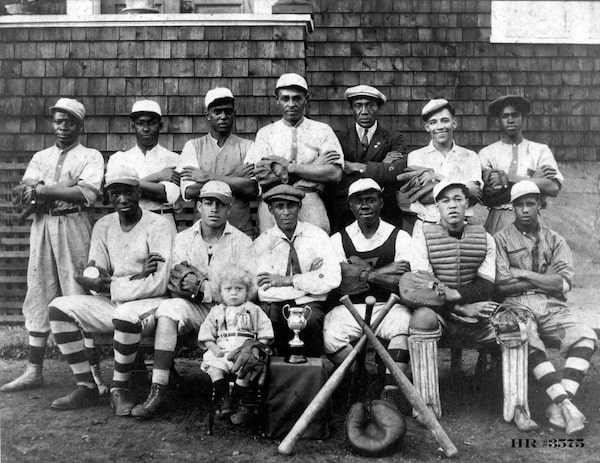
The South End Royals baseball team, circa 1922.Heritage Resources, Saint John/Handout
When the Detroit Clowns roared into Saint John in 1922, the American club expected to walk all over the local competition. But the barnstorming professional team, like baseball’s version of the Harlem Globetrotters, found nothing funny about the way the Canadians played.
They lost two of three games in the port city after running into one of the best baseball teams to come out of Atlantic Canada, the Saint John Royals. The Royals, a little-known all-Black team, traced their roots to a circuit of Black teams that had been playing around the Maritimes since the 1880s.
Black baseball was once a thriving scene on the East Coast, with top teams in Halifax, Amherst, Truro, Dartmouth, Moncton, Woodstock, Fredericton and Saint John challenging each other, through newspaper ads, to games that would draw thousands of fans. In the 1890s, they created a regional Maritime championship and would hop boxcars, steamships or later even into the back of trucks to get to games, playing in cities where they were banned from staying in hotels or eating inside local restaurants.
By the 1920s, Black Canadians still endured significant social and economic segregation and lived with often oppressive racism. But baseball was one area where they could be respected by white society and could bring pride to their neighbourhoods. Few teams brought more joy than the high-flying Royals, who dominated both regional championships and intercity play.
The Royals were led by their star pitcher, Fred Diggs, a rubber-armed hurler who reportedly threw harder than anyone else in the Maritimes. He could throw fastballs all day long – he once led the Royals to a sweep of a doubleheader, pitching all 18 innings himself without rest.
Local sportswriters thought Diggs was good enough to pitch in the major leagues. But in 1922, the idea of a Black pitcher from New Brunswick playing in the majors was a distant dream. Saint John’s baseball hotbed may have produced Bill Phillips, a white player who signed with the Cleveland Blues in 1879 – the first Canadian to play in the big leagues – but a team of working-class Black dockyard labourers had no such hope.
It would be 1946 before a Black player would become the first Canadian to break modern baseball’s colour barrier, when Fredericton’s Manny McIntyre started at shortstop for the Sherbrooke Canadiens, a farm team of the St. Louis Cardinals. Roger Nason, a New Brunswick historian, said McIntyre owed a lot to the Black baseball players who came before him.
One of those groundbreaking 19th-century teams, the Fredericton Celestials, featured Charles O’Ree and George O’Ree, the grandfather and great uncle of Willie O’Ree, who became the first Black player in the NHL.
“The early history of Black baseball in the Maritimes laid the foundation for all of that,” said Colin Howell, a retired historian from Saint Mary’s University in Halifax, whose book, Northern Sandlots: A Social History of Maritime Baseball, documents this unique time.
“It made it possible for some whites in that era to regard Black people without disdain. It was really through sport that Blacks were given more respect. It was an important ground that the civil-rights movement emerged from.”
Early Black baseball in the Maritimes was seen as a more social, entertaining alternative. In Saint John, white baseball was often divided along religious lines, making for sometimes-vicious encounters. Irish Catholics rooted for the Shamrocks, while Protestants pulled for the St. Johns – and their clashes on the diamond and in the stands were often bloody affairs.
One rum-soaked game in 1890 was so rowdy the city’s authorities banned the teams from playing each other. Black baseball games offered fans a chance to be entertained without the fear of a riot breaking out.
“They drew sizeable crowds wherever they played,” Nason said. “They were games you wanted to attend.”
The best Black players typically came from the poorest neighbourhoods. A newspaper account of a game between the Halifax Stanleys and the Royals in 1888 – a 37-11 blowout that reportedly drew 1,500 to a field in Saint John – said fans marvelled at their skill, but were surprised some played barefoot because they couldn’t afford shoes.
Many of the earliest Black teams were formed by business leaders, some of them descendants of former slaves who had fled the U.S., often with an eye to advancing their communities and encouraging racial pride. One Saint John team called itself the Ralph Waldo Emerson Colored Baseball Club, after the American poet-philosopher and well-known abolitionist.
The earliest-known mention of an all-Black baseball team anywhere in Canada came in 1869, when the Lincoln Nine – a reference to Abraham Lincoln – began playing in London, Ont. It’s believed Black Canadians probably started playing baseball a lot earlier than that, when waves of them came north during the U.S. Civil War.
Because they were banned from playing white teams, Black teams in the 19th century had to find a different way to draw crowds. They developed a reputation for hamming it up, while leaving fans impressed at their athleticism and unique, smooth, exuberant style.
“They played a different kind of game, they played a lot more hit-and-run, more stolen bases, small ball instead of swinging for the fences,” said Bill Humber, one of Canada’s pre-eminent baseball historians.
By the 1920s, the Saint John Royals, however, were a serious team. They weren’t playing for laughs. With standout players such as Alfonse Hogan, a boxer who played third base, catcher Ace Austin and first baseman Kid Tynes, they handily beat the best white and Black teams in the region, and visiting teams from the U.S. In 1922, they were in a league of their own, with a .833 winning percentage.
But baseball remained firmly divided by race then, and no matter how good they were, there were limits on the Royals that didn’t exist for white players. Any dreams they may have had of making a living in the big leagues were simply that.
“The key thing isn’t whether they were capable of playing at a higher level. It’s whether they had an opportunity to do that,” Humber said. “And it just wasn’t there.”
 Greg Mercer
Greg Mercer